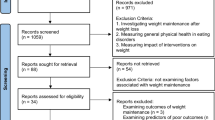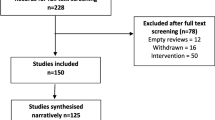Abstract
There are a growing number of cancer survivors in the USA. Despite lifestyle behaviors being strongly associated with morbidity and mortality following primary treatment, recruitment to clinical research studies that aim to improve such behaviors remains a significant challenge. Furthermore, pilot and feasibility studies are critical for the refinement of research methods and form an important training opportunity for early career scientists. This report details the challenges faced and lessons learned in the process of recruiting a population of overweight/obese endometrial cancer survivors (ECS) to two separate studies focused on lifestyle behaviors: a survey study and a randomized behavioral intervention study that aimed to improve diet, physical activity, and quality of life. We used in-clinic and mail-based approaches to reach eligible patients identified from clinic records. Surveys were offered via paper or online. To evaluate the recruitment process, we compared clinic records and enrollment data over time and location. Chi-squared tests were also used to compare recruitment strategies. We address specific challenges at the patient level, the clinic/provider level, and the organizational level. Overall response rate was 13.9% to the survey and 4% to the intervention. Responses to in-clinic offers were greater than to mail-based approaches for the survey with no difference for the intervention. Identifying the unique characteristics of each survivorship population, adequate planning, resource allocation, and involvement of key staff are essential to supporting recruitment efforts to research studies. Having the support of physicians and nurses is especially critical to the success of recruitment.

Similar content being viewed by others
References
Akkuzu G, Kurt G, Guvenc G, Kok G, Simsek S, Dogrusoy S, Ayhan A 2016. Learning needs of gynecologic cancer survivors. J Cancer Educ: 1–7. doi:10.1007/s13187-016-1118-y.
Babatunde OA, Adams SA, Orekoya O, Basen-Engquist K, Steck SE (2016) Effect of physical activity on quality of life as perceived by endometrial cancer survivors: a systematic review. Int J Gynecol Cancer 26(9):1727–1740. doi:10.1097/IGC.0000000000000821
Basen-Engquist K, Carmack CL, Li YS, Brown J, Jhingran A, Hughes DC, Perkins HY et al (2013) Social-cognitive theory predictors of exercise behavior in endometrial cancer survivors. Health Psychol 32(11):1137–1148. doi:10.1037/a0031712
Basen-Engquist K, Scruggs S, Jhingran A, Bodurka DC, Lu K, Ramondetta L, Hughes D, Taylor CC (2009) Physical activity and obesity in endometrial cancer survivors: associations with pain, fatigue, and physical functioning. Am J Obstet Gynecol 200(3):288.e281-288. doi:10.1016/j.ajog.2008.10.010
Chia VM, Newcomb PA, Trentham-Dietz A, Hampton JM (2007) Obesity, diabetes, and other factors in relation to survival after endometrial cancer diagnosis. Int J Gynecol Cancer 17(2):441–446. doi:10.1111/j.1525-1438.2007.00790.x
Courneya KS, Karvinen KH, Campbell KL, Pearcey RG, Dundas G, Capstick V, Tonkin KS (2005) Associations among exercise, body weight, and quality of life in a population-based sample of endometrial cancer survivors. Gynecol Oncol 97(2):422–430. doi:10.1016/j.ygyno.2005.01.007
Denicoff AM, McCaskill-Stevens W, Grubbs SS, Bruinooge SS, Comis RL, Devine P, Dilts DM et al (2013) The National Cancer Institute-American Society of Clinical Oncology cancer trial accrual symposium: summary and recommendations. J Oncol Pract 9(6):267–276. doi:10.1200/jop.2013.001119
Dillman DA (1978) Mail and telephone surveys: the total design method. Wiley & Sons, New York
Fayter D, McDaid C, Eastwood A (2007) A systematic review highlights threats to validity in studies of barriers to cancer trial participation. J Clin Epidemiol 60(10):990.e991–990.e933. doi:10.1016/j.jclinepi.2006.12.013
Gul RB, Ali PA (2010) Clinical trials: the challenge of recruitment and retention of participants. J Clin Nurs 19(1–2):227–233. doi:10.1111/j.1365-2702.2009.03041.x
Klabunde CN, Keating NL, Potosky AL, Ambs A, He YL, Hornbrook MC, Ganz PA (2011) A population-based assessment of specialty physician involvement in cancer clinical trials. J Natl Cancer Inst 103(5):384–397. doi:10.1093/jnci/djq549
Laskey RA, McCarroll ML, von Gruenigen VE (2016) Obesity-related endometrial cancer: an update on survivorship approaches to reducing cardiovascular death. Br J Obstet Gynaecol 123(2):293–298. doi:10.1111/1471-0528.13684
Lukowski J, Gil KM, Jenison E, Hopkins M, Basen-Engquist K (2012) Endometrial cancer survivors' assessment of the benefits of exercise. Gynecol Oncol 124(3):426–430. doi:10.1016/j.ygyno.2011.11.002
Maddams J, Brewster D, Gavin A, Steward J, Elliott J, Utley M, Moller H (2009) Cancer prevalence in the United Kingdom: estimates for 2008. Br J Cancer 101(3):541–547. doi:10.1038/sj.bjc.6605148
Martin MY, Pisu M, Manne S, Basen-Engquist K, Alfano C (2014) To evaluate efficacy, we need to reach: how do we recruit cancer survivors and family members to psychosocial research studies? In Ann. Behav. Med.: Springer 233 Spring St, New York, NY 10013 USA
McCarroll ML, Armbruster S, Pohle-Krauza RJ, Lyzen AM, Min S, Nash DW, Roulette GD, Andrews SJ, von Gruenigen VE (2015) Feasibility of a lifestyle intervention for overweight/obese endometrial and breast cancer survivors using an interactive mobile application. Gynecol Oncol 137(3):508–515. doi:10.1016/j.ygyno.2014.12.025
Miller KD, Siegel RL, Lin CC, Mariotto AB, Kramer JL, Rowland JH, Stein KD, Alteri R, Jemal A (2016) Cancer treatment and survivorship statistics, 2016. CA Cancer J Clin 66(4):271–289. doi:10.3322/caac.21349
Minasian LM, O'mara AM (2011) Accrual to clinical trials: let's look at the physicians. J Natl Cancer Inst 103(5):357–U1500. doi:10.1093/jnci/djr018
Modesitt SC, Geffel DL, Via J, Weltman AL (2012) Morbidly obese women with and without endometrial cancer: are there differences in measured physical fitness, body composition, or hormones? Gynecol Oncol 124(3):431–436. doi:10.1016/j.ygyno.2011.11.013
Soliman PT, Bassett RL, Wilson EB, Boyd-Rogers S, Schmeler KM, Milam MR, Gershenson DM, Lu KH (2008) Limited public knowledge of obesity and endometrial cancer risk—what women know. Obstet Gynecol 112(4):835–842. doi:10.1097/Aog.0b013e318187d022
Song J, Karlsten M, Yamal JM, Basen-Engquist K 2016. Health-related quality of life factors associated with completion of a study delivering lifestyle exercise intervention for endometrial cancer survivors. Qual Life Res:1–9. doi:10.1007/s11136-016-1441-0
Topolovec-Vranic J, Natarajan K (2016) The use of social media in recruitment for medical research studies: a scoping review. J Med Internet Res 18(11):e286. doi:10.2196/jmir.5698
von Gruenigen VE, Courneya KS, Gibbons HE, Kavanagh MB, Waggoner SE, Lerner E 2008. Feasibility and effectiveness of a lifestyle intervention program in obese endometrial cancer patients: a randomized trial. Gynecol Oncol 109 (1). doi:10.1016/j.ygyno.2007.12.026.
von Gruenigen VE, Courneya KS, Gibbons HE, Kavanagh MB, Waggoner SE, Lerner E (2008) Feasibility and effectiveness of a lifestyle intervention program in obese endometrial cancer patients: a randomized trial. Gynecol Oncol 109(1):19–26. doi:10.1016/j.ygyno.2007.12.026
von Gruenigen VE, Waggoner SE, Frasure HE, Kavanagh MB, Janata JW, Rose PG, Courneya KS, Lerner E (2011) Lifestyle challenges in endometrial cancer survivorship. Obstet Gynecol 117(1):93–100. doi:10.1097/AOG.0b013e31820205b3
von Gruenigen V, Frasure H, Kavanagh MB, Janata J, Waggoner S, Rose P, Lerner E, Courneya KS (2012) Survivors of uterine cancer empowered by exercise and healthy diet (SUCCEED): a randomized controlled trial. Gynecol Oncol 125(3):699–704. doi:10.1016/j.ygyno.2012.03.042
Acknowledgements
This work was supported by NIH/NCI 5R25 CA122061 a Food Innovation Center (FIC) award of The Ohio State University and the Pelotonia Fellowship Program. Any opinions, findings, and conclusions expressed in this material are those of the author(s) and do not necessarily reflect those of the Pelotonia Fellowship Program.
Author information
Authors and Affiliations
Corresponding author
Rights and permissions
About this article
Cite this article
Lucas, A.R., Focht, B.C., Cohn, D.E. et al. Recruiting Endometrial Cancer Survivors to Studies Examining Lifestyle Behaviors and Quality of Life: Challenges Faced and Lessons Learned. J Canc Educ 33, 857–864 (2018). https://doi.org/10.1007/s13187-017-1187-6
Published:
Issue Date:
DOI: https://doi.org/10.1007/s13187-017-1187-6




